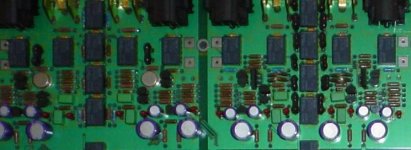PMA, the examples were very primitive, nevertheless, at least 40 years behind. I hate to remind everyone, but we in the USA went to the moon in '69, and we had lots of heavy engineering behind it, some of which spilled out into the audio sector. When I look at such examples, it only reminds me as to how far ahead hi end design generally is over what people even know exists. 

Hi,
regarding MC, not just noise is a problem, the extremely small amount of energy involved as well. Just a very few devices have the ability to handle so weak signals satisfactorily, others cause (considerably) more losses and distortion. Parallelling does not help, means sonic degradation. However, such annoyances usually don`t make simulation data less fabulous.
For the orthodox minded only battery supply is acceptable.
regarding MC, not just noise is a problem, the extremely small amount of energy involved as well. Just a very few devices have the ability to handle so weak signals satisfactorily, others cause (considerably) more losses and distortion. Parallelling does not help, means sonic degradation. However, such annoyances usually don`t make simulation data less fabulous.
For the orthodox minded only battery supply is acceptable.
Yes, paralleling of parts does not lose information, and is often necessary for lowest noise. Power transfer is NOT the same as signal transfer. We have known how to do this since 1966, due to a paper in the IEE's 'Electronic Letters' found in research labs and in technical libraries at the time, and even today.
john curl said:PMA, the examples were very primitive, nevertheless, at least 40 years behind.
I just opened the paper - you are right, of course. The designs were mainly for cheap PC based measuring cards, I know the story.
john curl said:ksh device is OK for microphones, lousy for phono in general.
It does state "capacitor microphone applications" in the data sheet. I assume it is has to do with the phono pickup being inductive? Or is this another point of insight chalked up to "experience"?
I have been producing world class pre-preamps for the last 35 years. Most here are rank amateurs, without experience, understanding, or even having done the computations necessary to determine what they are stating. I just can't cope with this disparity in understanding and experience. It is pointless. Also, 50 ohms is usually too low, 100-200 ohms is usually better with modern cartridges. Capacitance is optional and should point out the silliness of worrying about the intrinsic capacitance of the input devices.
Charles Hansen said:
But to me, this is so elementary that it's not worth wasting much time on. If your circuit has trouble driving the EQ network, then you shouldn't be designing circuits. There are much more subtle points to work on and achieve real improvements than to waste time on these types of basic problems that have been understood for decades.
So, which of the designs testet by audiophile didn't reflect the 'basic problems that have been understood for decades'?
thanks,
Rüdiger
PMA said:to cover and switch
Is that a problemo ?
Moving coil stage on the left side of the picture. (RIAA is not on it)
The various combinations are PIC stored and push button selected, same-same for the MM stage on the right.
Attachments
- Status
- This old topic is closed. If you want to reopen this topic, contact a moderator using the "Report Post" button.
- Home
- Source & Line
- Analogue Source
- Solid state phono preamp design philosophy

